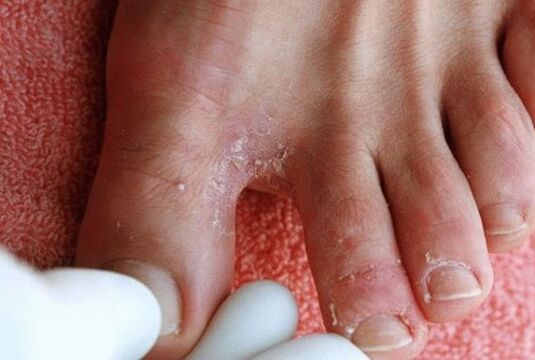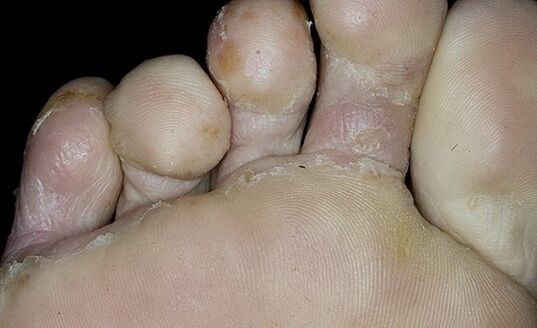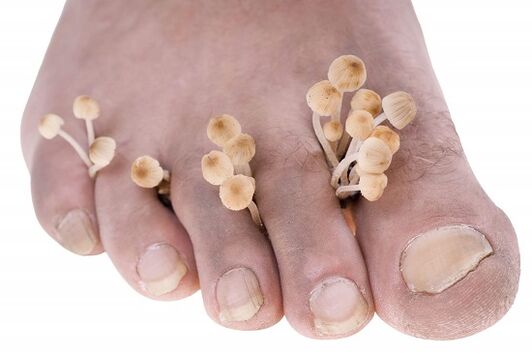In the minds of many people, patients with thrush are often associated with clutter, laziness, and dust. This assumption is not entirely correct. In the modern world, even the cleanest places are not immune to fungal infections. Furthermore, a person with an active and healthy lifestyle is more at risk of disease than a classic couch potato. If the skin between your toes turns red, peels and cracks, your nails turn yellow and crumbles, and the uncomfortable itchy feeling doesn't leave for a minute, you most likely have a fungal infection.
Pathways of infection
Medical statistics say that every 4-5 people on our planet suffer from toe fungus. The risk of infection is everywhere: in swimming pools, saunas, gyms, public baths, shoe stores, on the beach, and even your shoes often become the environment. excellent environment for the life and active reproduction of fungi.

Walking barefoot, wearing someone else's shoes or wet shoes, sharing toiletries (towels, manicure and pedicure tools), dirty socks, excessive sweating, degenerative foot disease, overweight, circulatory disorders - these and other factors directly or indirectly lead to fungal infections.
Healthy nails are practically invulnerable to fungus, while nails, altered under the influence of some traumatic factors, are easy prey for him. The same goes for the skin - microscopic cracks in the skin become gateways for infection.
Usually, the infection is caused by fungal parasites called dermatophytes, less often by yeasts and molds. Toe fungus of men and women are equally affected. The risk of infection increases with age. It is therefore relatively rare for children to fall victim to this parasite, while every second adult after the age of 70 is an active carrier of it.
The first symptoms of toe fungus

In most cases, fungal infections of the feet occur gradually in the following pattern:
- the first signs in the form of peeling of the skin, burning and itching are observed between the toes;
- the skin reacts to the infection with the formation of bubbles, after a while they crack;
- cracks and grooves appear in the place of the bubbles; intense itching;
- on the nails, the fungus actively multiplies, gradually entering the nail, which slowly and permanently destroys it;
- plaque thickens, flakes, crumbles, has an unnatural yellow color.
Tinea capitis appears as bright yellow spots or stripes near the edges of the nails. Over time, the infection moves to its central part, the skin in the area between the cracks, and feels intensely itchy. Yeast feeds on the nail plate, thinning it from the sides. As a result, waves, grooves, cracks appear, the nail turns yellow and separates from its bed. First, the yeast attacks the folds of the nail. They turn red, thicken and swell, silvery scales appear along the edges. It is possible to attach a secondary bacterial infection later. Mold affects the nails visually, changing their color from yellow and green to brown and even black. These fungi are especially active in the condition of impaired nutrition of the nail plates.
Why can't you wait to see a doctor?
Treatment should be started as soon as possible. It's good if this happens before the infection, which is usually localized first between the toes, spreads to the fingernails. Seek medical attention early to ensure your nails heal faster and are healthier.

A mycologist will be involved in the treatment of various fungal skin lesions (mycoses). Doctors of this record are difficult to find in state clinics. In the absence of this, you can consult a dermatologist. The specialist's job is to assess the extent and depth of the lesion, scrape the tissue to determine the presence and type of fungus, and prescribe the appropriate treatment.
Before starting treatment, it is necessary to carry out disinfecting actions, including treating all shoes with vinegar or a solution of formalin. The bad smell of these products makes them uncomfortable to use. To solve the problem, you can buy a special device at the pharmacy to disinfect shoes with ultraviolet light.
Traditional treatment for toe fungus
Toe fungus can be treated with topical, systemic, or combination therapy.

Any treatment that involves the use of antispasmodics (antifungal drugs):
- Topical treatment (ointments, creams, sprays). Antipyretics for external use and other medicines whose active ingredient is clotrimazole, naftifine hydrochloride, ketoconazole, terbinafine hydrochloride or bifonazole. In case of minor damage to the nail, an antifungal polish should be used. Varnish is applied all year round, gradually reducing the frequency of use (from 4 to 1 time / week). Topical remedies have the effect of reducing itching, burning, reducing peeling and cracking of the skin between the toes but are not able to completely cure the disease.
- Systemic treatment: general antipyretic. Such treatment is appropriate in cases where the nail is completely damaged. But there are certain contraindications to systemic antifungal drugs: pregnant and lactating women, people with liver and kidney disease and young children should not take it.
- Comprehensive treatment. Includes topical and systemic therapy.
Patients often complain about the ineffectiveness of traditional therapies and must be treated with folk remedies. In the face of such complaints, it is thought that foot fungus is an incurable disease, which can only temporarily eliminate its symptomatic manifestations (itching, peeling skin, cracking). Why is patient dissatisfaction observed? Everything is very simple. In fact, completely curing a fungus is very difficult, but possible. The main thing is to adhere to the principles of regularity and duration. It is very important to do all the therapeutic activities every day and not to interrupt what you have started midway. You need to be ready for the long-term treatment (usually 3-12 months), which makes sense to proceed until the new healthy nail grows back. In severe cases, it is necessary to remove the affected nail plates and only then wait for the appearance of new ones.
Treatment of toe fungus with folk remedies
Traditional medicine formulations are very effective in eliminating or reducing the severity of fungal manifestations such as itching, burning, cracking, peeling and redness of the skin between the toes. Some patients claim that they were able to completely cure this disease with folk remedies.

So to deal with fungus:
- Soak your feet with apple cider vinegar, wine vinegar, or vinegar.
- apply 1 drop of iodine to each nail twice a day;
- wipe your skin and nails with salicylic ointment;
- wash feet with laundry soap;
- make garlic and butter compress;
- lubricate the affected skin with a mixture of garlic juice, alcohol (1 tablespoon each) and water (2 tablespoons);
- Treat the affected area with propolis tincture.
According to reviews, garlic and propolis are especially effective against fungi. It is important to understand that the duration of treatment with folk remedies has its limitations. If within 3 months the skin cracks and does not have the same appearance, you should seek the help of traditional medicine.
Despite the good efficacy of folk remedies and the success of modern pharmaceuticals in inventing new effective drugs, foot fungus today remains the most common fungal disease. However, the good news is that over the past 20-30 years, the number of patients successfully cured has been decreasing every year.



























